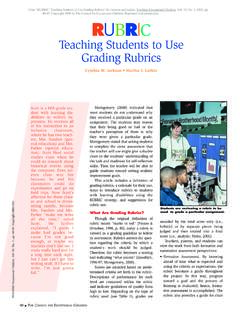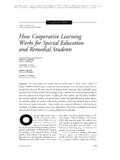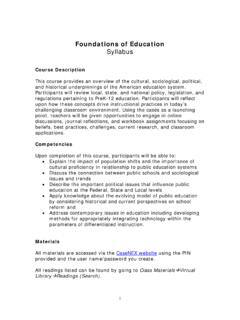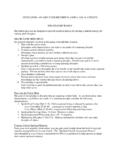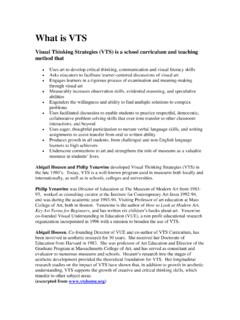Transcription of The Importance of Teacher Self-Awareness in Working With ...
1 What are your primary concerns in theclassroom? Are you constantly involvedin power struggles with some students?Do you yearn for good relationshipswith all your students? Are you stressedout? This article may frequency and intensity of stu-dents emotional and behavioral disor-ders have increased in the past severaldecades (Bartollas & Miller, 1998;Knitzer, 1993; Lerner, 1995; Long,Morse, & Newman, 1996). In surveys,teachers consistently reveal that disrup-tive student behavior and classroomdiscipline are their primary educationalconcerns (Long, 1996a). Teachers whowork with students with emotional andbehavioral disorders can enhance theireffectiveness and job satisfaction, mini-mize power struggles, and build morepositive relationships with children withdisabilities by taking proactive steps toincrease their own Self-Awareness . Goldand Roth (1993) identified Teacher Self-Awareness as a key component for man-aging stress.
2 Gold and Roth (1993) defined Self-Awareness as a process of getting intouch with your feelings and behaviors (p. 141). Increased self -awarenessinvolves a more accurate understandingof how students affect our own emo-tional processes and behaviors and howwe affect students, as well. self -aware-ness is particularly important for teach-ers who work with students with emo-tional and behavioral disorders. Seldomare we unaffected by their , these students reflect the bestand worst in ourselves (Richardson,2001). Our development as teachersdepends on our willingness to take risksand regularly ask ourselves which ofour own behaviors are helping or hin-dering our personal and professionalgrowth. If we could allow ourselves tobecome students of our own extraordi-nary self -education, we would be verywell placed to facilitate the self -educa-tion of others (Underhill, 1991, p. 79).This article identifies questions andstrategies to help teachers become moreself-aware regarding their interactionswith students with behavioral and emo-tional COUNCIL FOREXCEPTIONALCHILDRENTEACHING Exceptional Children, Vol.
3 36, No. 2, pp. 8-13. Copyright 2003 Importance of Teacher Self-Awareness in Working With Students WithEmotional and BehavioralDisordersBrent G. Richardson Margery J. ShupeTeachers revealed that disruptivestudent behavior and classroomdiscipline are their primaryeducational development as teachersdepends on our willingness totake stock of our own of DisruptiveBehaviorFrom The Importance of Teacher Self-Awareness in Working with Students with Emotional and Behavioral Disorders by Richardson and Shupe, Teaching Exceptional Children, Vol. 36, No. 2, 2003, pp. 8-13. Copyright 2006 by The Council for Exceptional Children. Reprinted with permission. Five Key Questions to IncreaseTeacher I taking proactive steps toidentify and defuse my own emotional triggers ?Cheney and Barringer (1995) asserted: More than any other group, studentswith emotional and behavioral disor-ders appear to present problems thataffect staff members on a very personallevel (p.)
4 181). Unfortunately, teachereducation does not always highlight theconnection between a Teacher s Self-Awareness and his or her ability to buildand maintain meaningful relationshipswith youth with emotional and behav-ioral disabilities. Although teachersneed to learn how to recognize signs ofemotional distress in their students, it isequally important to acknowledge thatteachers own personalities, learnedprejudices, and individual psychologicalhistories have helped shape their atti-tudes and responses to certain behav-iors (Long et al., 1996). Fritz Redl, a pio-neer in Working with students withemotional disturbances, emphasizedthat Self-Awareness is a key ingredientfor succeeding with this population:As teachers we have a room, agroup, equipment, materials, acurriculum, instructional meth-ods, and grades, but most of all,we have ourselves. What hap-pens to us emotionally in theprocess of teaching emotionallydisturbed kids is the critical factorin determining our effectiveness.
5 (cited in Long, 1996a, p. 44)Helping youth with emotional andbehavioral disabilities begins withunderstanding ourselves, particularlyour own emotional processes that occurin the midst of conflict. Although psy-chological soundness and effectiveinterpersonal skills are essential charac-teristics for teachers who work with thispopulation (Kaufman, 1997; Webber,Anderson, & Otey, 1991), certain stu-dents can provoke even the most con-cerned, reasonable, and dedicatedteachers to act in impulsive, acrimo-nious, and rejecting ways (Long,1996a). Students experiencing stresshave the capacity to locate and activateunresolved issues in our own personallives. Few of us possess the inner peaceto respond in a calm and professionalmanner without conscious of our primary emotionaltriggers improves our chances of mak-ing rational decisions based on con-scious choice, rather than unconsciousemotional , the psychological fitbetween a Teacher s need to stay in con-trol and a youth s inability to maintaincontrol can lead to counterproductivepower struggles (Long, 1996a).
6 Longasserted that by taking ownership of negative feelings such as anger, frus-tration, and disdain, we are more likelyto recognize the difference betweenhaving feelings and being had by ourfeelings. Teachers who are aware oftheir own emotional processes are morelikely to minimize the frequency andintensity of these counterproductivepower struggles (see box, Strategy forIdentifying and Defusing EmotionalTriggers ). I paying attention to what Ineed to pay attention to?Most teachers recognize the power andnecessity of using positive reinforce-ment (Johns & Carr, 1995). By con-sciously noticing and reinforcing posi-tive behavior, the classroom becomes amore positive environment one inwhich the recognition of both academicand behavioral accomplishments leadsto increased student self -esteem (Fagan,1996). In an extensive study of effectiveteaching behaviors for students withdisabilities, Larrivee (1982) found that giving positive feedback to be abehavior positively correlated with stu-dent performance measures.
7 Johns andCarr recommended that at least 70% ofcomments teachers give studentsshould be positive. Although research-ers have found Teacher praise to belinked to improved behavioral and aca-demic outcomes of students with emo-tional and behavioral disorders, the useof praise in these classrooms is oftenlow (Sutherland & Wehby, 2001).Good and Brophy (1984) found thatteachers perceptions of students canTEACHING EXCEPTIONALCHILDREN NOV/DEC2003 9 Strategy for Identifying and Defusing Emotional TriggersTake periodic timeouts before, during, or after both positive and negative interactions with students. Ask yourself: What led me to respond this way? Is this way of responding helping or hurting this relationship? Is it helping me grow as an educator? Is it helping the youth make better choices? It is important to remember that we are often unaware of our primary emo-tional triggers. Actively seek consultation from colleagues and supervisors regard-ing behaviors and/or attitudes which are helping or hurting your effectiveness inthe a colleague or supervisor: What do you see as my biggest strength in Working with students with behav-ioral and emotional disorders?
8 What types of problems or student behaviors do I find the most difficult? Helping youth with emotional andbehavioral disabilities begins withunderstanding ourselves,particularly our own emotionalprocesses that occur in the midstof often inadvertentlyneglect to recognize and build onstudents positive behaviors teaching outcomes. Teachers whowork with students with emotional andbehavioral disabilities can become soattuned to problem behaviors and per-ceived weaknesses, they inadvertentlyneglect to recognize and build on posi-tive behaviors and strengths. AMinnesota youth poll by Hedin,Hannes, & Saito (as cited in Braaten,1999) revealed that two thirds ofrespondents believed that they wereperceived negatively by the significantadults in their lives. Only 25% believedthat adults held positive images ofthem. Furthermore, a large proportiondid not believe the adults perceptionsof them to be accurate.
9 The researchersconcluded that the youths believe thatadults do not value or trust them and donot treat them with respect, and thisbelief increases as the youths growolder. In their study of Teacher behav-iors, Sutherland and Wehby (2001)found that ongoing Teacher self -assess-ment had a positive impact on Penny Transfer Technique is onestrategy teachers can use to help themshift their focus to more positive studentbehaviors and attributes (see box, Strategy for Shifting Your Focus ).Richardson (2001) noted that profes-sionals who have used the PennyTransfer Technique have found that (a)they began to automatically notice pos-itive behaviors of problem students and(b) they were able to change their per-ceptions and thus improve their rela-tionships with these I using effective strategiesto reduce burnout and nurture myown mental health?Teaching students with emotional andbehavioral disorders is one of the mostperplexing and challenging roles in edu-cation (Cheney & Barringer, 1995).
10 These teachers are faced with enormouspressures and simultaneous challenges(Cheney & Barringer; Pullis, 1992) andreport high levels of emotional exhaus-tion (Male & May, 1997). They are eval-uated primarily on their ability to helpstudents make tangible, academicimprovements (Long, 1996b); yet theyare also expected to assume multipleroles, such as model, disciplinarian, sur-rogate parent, social worker, and teachers find it difficult to per-form all these roles in the midst ofdecreasing budgets and increasing classsizes. Teachers find themselves strug-gling to find time to adequately covereach of the learning objectives whilealso attending to the emotional needs oftheir students. Teacher stress canadversely affect the teachers, their stu-dents, and the classroom and Barringer (1995) found thatstress can be manifested as (a) a reluc-tance to consider factors beyond theimmediately observable behavior of thestudent, and (b) a rigid focus on schoolrules as a way of coping with problem-atic social interactions (p.)
